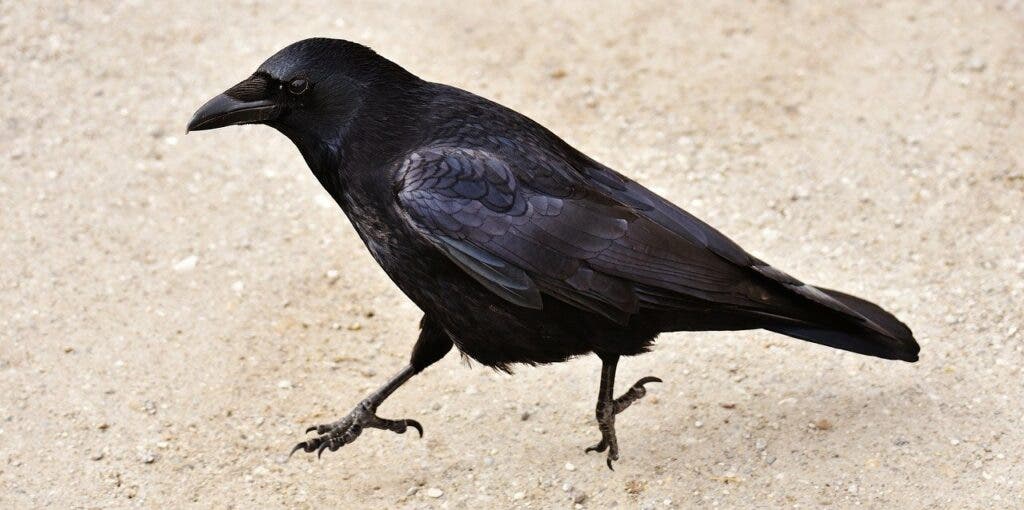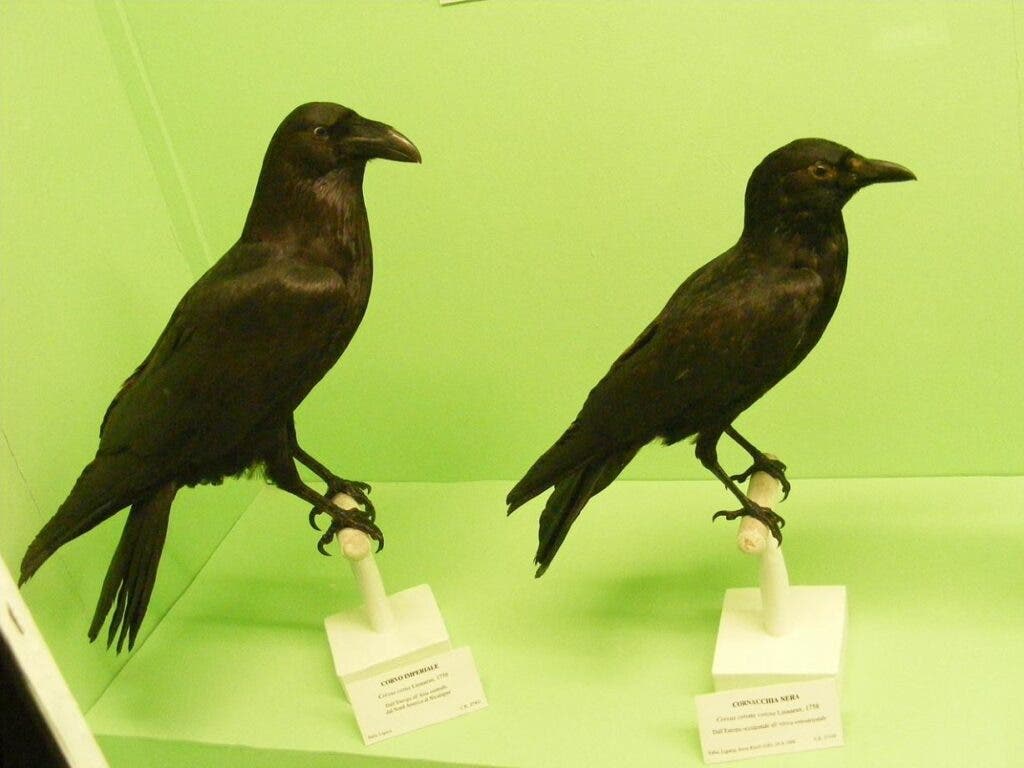Although these two terms are used interchangeably, these two species are not the same. Although the differences between them are subtle, we can learn to tell the two apart. So let’s get to it!

Ravens and crows are closely related. They both belong to the Corvus genus of the Corvidae family of birds. Outwardly, they’re very similar — both are jet black and share several morphological features. Their natural ranges also have a lot of overlap, so they’re often seen (and mistaken for one another) in the same areas of the world.
Here is where the terms get a bit muddy, however. “Crow” is often used as a catch-all term for any bird in the genus Corvus. At the same time, people tend to refer to any larger bird from this genus as a “raven”. Taken together, it’s easy to see why very few people seem to be able to describe with any real detail what truly differentiates these species.
But — lucky you! — we’re about to go through them today.
Crow or raven?
One of the first indications that you’re seeing a crow rather than a raven is that the former generally travels in large groups, while the latter prefers to hang out in pairs. If we happen upon a solitary bird, however, such context clues won’t do us much good; so we’ll have to look at the characteristics of the individual.
Common ravens (Corvus corax) are, indeed, larger than your average crow. This is especially useful to know in rural areas, where size can be a pretty reliable indicator of which of these birds you’re dealing with. Ravens aren’t particularly fond of urban areas and their bustling crowds, however, so if you’re in a city, you’re probably more likely to be seeing a ‘really big crow’ than a raven. As a rule of thumb, crows are about the size of a pigeon and weigh on average 20 oz / o.55 kgs, while ravens are roughly as large as hawks, typically weighing 40 oz / 1.1 kgs.

Meanwhile “crows” — typically the Carrion Crow (Corvus corone) in Europe and American Crow (Corvus brachyrhynchos) in the U.S. — are quite fond of cityscapes and generally not people-shy.
The two species also produce different sounds. Crows vocalize through ‘caw’s or ‘purr’s (sound sample for carrion crows, American crows) while ravens use much lower, rougher croaks. Personally, I find the latter to sound much more ominous, and use this as a rough but reliable guideline when trying to identify ravens.
If vocalizations are not forthcoming, either, we can start looking at the physical features of the birds in question. As far as the plumage is concerned, both species sport jet-black feathers. Raven feathers are very glossy with green, blue, and purple iridescence; they can also have a wet or oily sheen. Crow feathers are iridescent blue and purple but are far less shiny than those of ravens (although they still do have a little bit of sheen to them).
Ravens have larger and curvier beaks than crows. Both sport bristles at the base of the beak, but for ravens, these are much more pronounced. Ravens tend to have ruffled feathers on the throat, whereas crows’ are swept neat and tidy.
On the ground, both birds behave similarly. One reliable way to tell a raven apart here, however, is by how they walk: ravens tend to mix little hops in their gait when moving more rapidly. At a slow pace, a raven’s walking pattern is the same as those employed by crows.
If you happen to spot the birds mid-flight, a few more tell-tale differences become apparent. A raven’s wingspan is much greater than that of a crow (3.5-4 ft / 1-1.2 m and 2.5 ft / 76 cm, respectively) and raven’s wing beats make a distinctive swishing sound while a crow’s are silent. In flight, the raven’s neck is also longer than a crow’s. Crows tend to actively flap their wings more often than ravens, which tend to prefer soaring on rising masses of air (they are heavier, and this helps them save energy). If you see such a bird soaring — gliding along with outstretched wings — for more than a few seconds at a time, chances are it’s a raven.
Ravens like to do all sorts of fancy acrobatics during flight, including somersaults (loops) or even flying upside-down, possibly just for fun. Such behavior is a dead giveaway that you’re looking at a raven, but it’s not very reliable; they tend to only engage in such playful behavior on windy days, or those with powerful thermals (rising masses of hot air) to keep them aloft.
As far as the shape of their wings is concerned, ravens have pointed wings with long primary feathers near their tip. Crows, meanwhile, have blunter wingtips; although their primaries are splayed as well, they are shorter and less pronounced than a raven’s.
Perhaps the single most distinctive difference between the two is the shape of their tails. All the feathers in a crow’s tail are the same length; in flight, their extended tails look like fans, with a rounded outline. Ravens meanwhile have longer feathers in the middle of their tails, giving them a wedge-like outline while the birds are in flight.
The differences between these two species are subtle — as well they should be, they are closely related, after all! The Corvidae family is also very numerous, and each species that belongs to it has its own particularities, some of which may not fit with what we’ve discussed here today. In general, however, they’re distinctive enough to tell apart.
Crows and ravens are some of the most similar — and most often-confused — species in this family. Hopefully the tips here will help you better tell them apart, and impress your friends with your knowledge of Corvidae!


